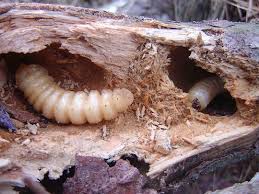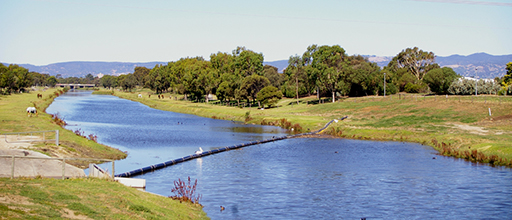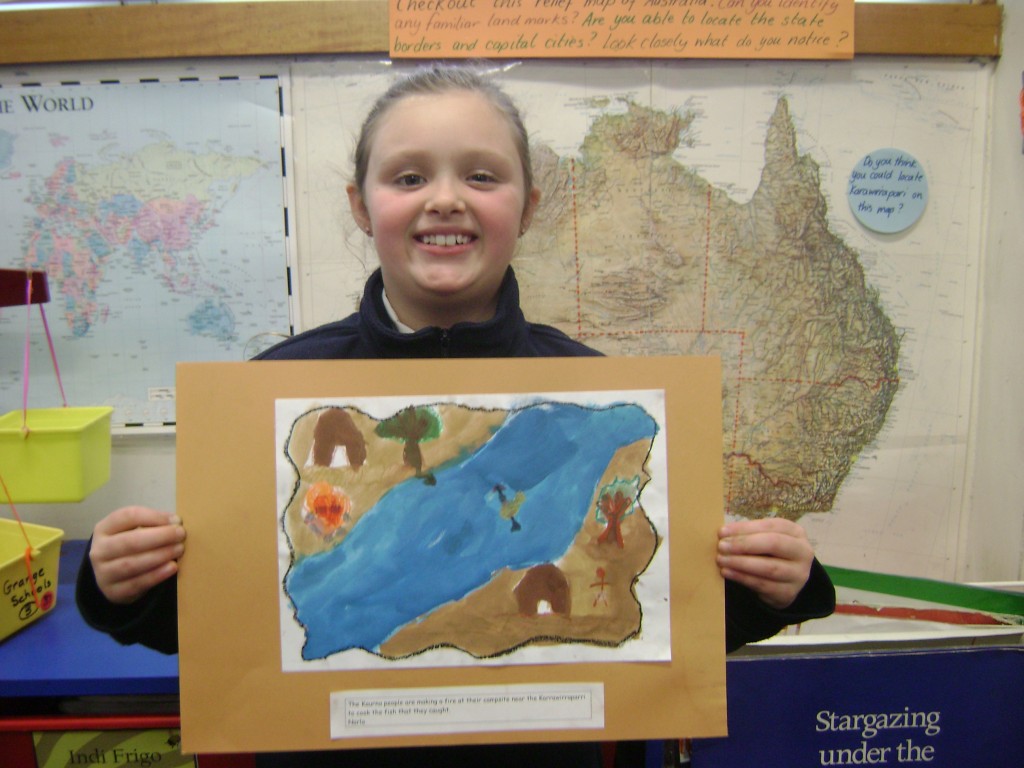Resource Based Learning RBL
This term we have been working closely with our knowledgable Librarian Janet Sweeney, who has been helping us learn more about the history of parts of South Australia. It’s important that we understand that things change over time and that while we might be familiar with things now, it may have been quite different in the past. Change affects people and environments, in some cases significantly and we need to understand these changes from different perspectives.
City of Adelaide from Mr Wilsons Section on the Torrens June 1885 G.F.Angas
We began by looking closely at The River Torrens which is a major river close to our school and very familiar to us all. Geography and mapping skills were needed to understand origins of the river from the source, the beginning, and the end, the mouth of the river.
Look closely, can you locate the River Torrens ?
We were able to use google Earth to find and locate the path of the River Torrens from the source in the foothills as it meanders its way across the Adelaide Plains east to west to the mouth at West Beach.
Researching the Past
We know that the river flows through the land of the Aboriginal people of Adelaide called the Kaurna people. They called the river Karrawirrapari which we learnt meant Red Gum Forrest River or sometimes it was called Tandaparri which meant Red Kangaroo River. The Kaurna people used the river for water, hunting and built campsites along the banks using resources from the river environment. Researching information about past events is history, so we needed to rely and build our literacy skills in locating information which was linked to the River Torrens environments from long ago.
Here a Kaurna male is cutting holes in the tree to help climb up and we can see signs of this activity today in this scar tree.
We discovered that the river was a place which provided a lot of food for the Aboriginals who camped nearby. Foods such as water fowl, cockles, fish and barti, which are witchetty grubs, these were found in the bark of the river gums. As the seasons changed we found out that the river changed from raging fast flowing flood waters in winter to small chains of small ponds in the summer months.
 Witchetty grubs like to live in the bark of trees close to the river and were quite a tasty snack for the Kaurna people.
Witchetty grubs like to live in the bark of trees close to the river and were quite a tasty snack for the Kaurna people.
It became very clear to us that Karrawirrapari was a very important resource for the lives of the Kaurna people in the past.
Building researching skills
We were given lots of information both written and visual to gather our facts. Note taking is a really important skill and can be a challenge. We needed to use lots of reading strategies to look at texts using their words and images, find key words and then summarising them into our own sentences.
Having notes meant that, once we examined the features of the genre explanation, we could order our sentences into a logical structure and explain what the river was like in the past. We used the same skills to discover facts about the present.
Researching the Present
Over the one hundred and seventy nine years of settlement the river has had many changes. We discovered that William Light who was the surveyor of Adelaide named River Torrens after his friend Robert Torrens. The river is a popular place for recreational activities for the people of Adelaide such as river cruises, paddle boats or having picnics along the banks. When people walk, ride or jog along the Linear Track, which runs along the river, they can see plaques that acknowledges both the indigenous and white settlement names Karrawirraparri and River Torrens.
We know too that bridges, paths and lights have been added for pedestrians and traffic. At the mouth of the river, to stop the land from flooding, cement banks and flood ways have been added.
Settlers brought with them non native animals that have escaped and are now using the river as a their habitat. The house mouse is now the most common mammal found along the river. The European Carp is destroying the natural habitat and is eating the native fish. However many original water fowl can still be found along the banks.
A major change to the river was the building of three reservoirs in the catchment areas which now provides Adelaide with 60% of our water supply.
As we researched the present day uses of River Torrens, we all agreed that the river continues to be an important part of Adelaide and we couldn’t imagine Adelaide without it.
Comparing the river at different times
An interesting task was to use a Venn diagram to compare similarities and differences with the past and present features of the river.
Art captures our images of the past
One way to show our understandings is to reflect and imagine scenes from days past. Using our knowledge of what the early river may have looked like, we created pictures using mixtures of coloured pencils, crayons and watercolours. We were inspired by looking back at some early landscape paintings. We were proud of our efforts. We wrote some sentences to describe the scene. What do you think?
What has been the most interesting part of our research for you?
What things do you along or on the River Torrens?
Do you have any questions about the river that may need further research?






























